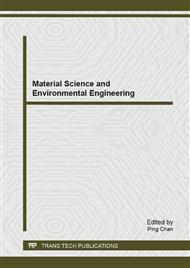[1]
Zhou R X, Dong K J. Talk about pesticide pollution and environmental protection, Xinjiang environmental protection, 1 (1999) 31-33.
Google Scholar
[2]
Anjaiah V, Thakur R P, Koedam N, Evaluation of Bacteria and Trichoderma for Biocontrol of Pre-harvest Seed Infection by Aspergillus flavus in Groundnut, Biocontrol Science and Technology, 16 (2006) 431-436.
DOI: 10.1080/09583150500532337
Google Scholar
[3]
Schubert M, Fink S, Schwarze F, Evaluation of Trichoderma spp. as a Biocontrol Agent against Wood Decay Fungi in Urban Trees, Biological Control, 45 (2008) 111-123.
DOI: 10.1016/j.biocontrol.2008.01.001
Google Scholar
[4]
Larralde-corona C P, Santiago-mena M R, Sifuentes-rincón A M, et al, Biocontrol Potential and Polyphasic Characterization of Novel Native Trichoderma Strains against Macrophomina phaseolina Isolated from Sorghum and Common Bean, Applied Microbiology and Biotechnology, 80 (2008).
DOI: 10.1007/s00253-008-1532-0
Google Scholar
[5]
Francesco V, Sivasithamparam K, Ghisalberti E L, et al. Trichoderma-Plant-Pathogen Interactions. Soil Biology and Biochemistry, 40 (2008) 1-10.
DOI: 10.1016/j.soilbio.2007.07.002
Google Scholar
[6]
López-mondéjar R, Ros M, Pascual J A. Mycoparasitism-related Genes Expression of Trichoderma harzianum Isolates to Evaluate Their Efficacy as Biological Control Agent. Biological Control, vol. 56, pp.59-66, January (2011).
DOI: 10.1016/j.biocontrol.2010.10.003
Google Scholar
[7]
Szabó M, Csepregi K, Gálber M, et al. Control Plant-parasitic Nematodes with Trichoderma Species and Nematode-trapping Fungi: the Role of chi18-5 and chi18-12 Genes in Nematode Egg-parasitism. Biological Control, 63 (2012) 121-128.
DOI: 10.1016/j.biocontrol.2012.06.013
Google Scholar
[8]
Peterbauer C K, Matteo L, Christopher K H, et al. Molecular Cloning and Expression of the nag1 Gene (N-acetyl-β-D-glucosaminidase-encoding Gene) from Trichoderma harzianum P1. Current Genetics, 30 (1996) 325-331.
DOI: 10.1007/s002940050140
Google Scholar
[9]
Song Jin-Zhu, Yang Qian, Liu Bei-Dong, et al. Expression of the Chitinase Gene from Trichoderma aureoviride in Saccharomyces cerevisiae. Applied Microbiology and Biotechnology, 69 (2005)39-43.
DOI: 10.1007/s00253-005-1957-7
Google Scholar
[10]
Nguyen N V, Young-ju K, Kyung-taek O, et al. Antifungal Activity of Chitinases from Trichoderma asperellum DY-59 and Rhizopus microsporus VS-9. CURR Microbiol, 56 (2008) 528-532.
DOI: 10.1007/s00284-007-9033-4
Google Scholar
[11]
Kumar D P, Rajesh K S, Anupama P D, et al. Studies on Exo-Chitinase Production from Trichoderma asperellum UTP-16 and its Characterization. Indian Journal of Microbiology, 52 (2012). 388-395.
DOI: 10.1007/s12088-011-0237-8
Google Scholar
[12]
Marcello C M, Andrei S S, Silvana Petrofeza da Silva, et al. Expression Analysis of the Exo-β-1, 3-glucanase from the Mycoparasitic Fungus Trichoderma asperellum. Microbiological Research, 165 (2010) 75-81.
DOI: 10.1016/j.micres.2008.08.002
Google Scholar
[13]
Ramot O, Viterbo A, Friesem D, et al. Regulation of Two Homodimer Hexosaminidases in the Mycoparasitic Fungus Trichoderma asperellum by Glucosamine. Current Genetics, 45 (2004) 205-213.
DOI: 10.1007/s00294-003-0478-0
Google Scholar


